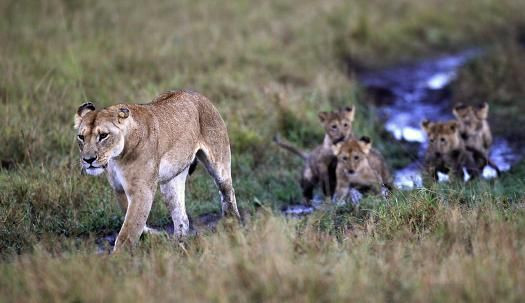The Stolen Savanna: As African Lions Die Out, Conservationists Call For Coexistence

Researchers at Duke University have some bad news for Simba.
The most fearsome predators of the African savanna are being crowded out by humans, says a study published this week in the journal Biodiversity and Conservation. The findings are astounding: The continent’s lion population has decreased by shocking two-thirds over the last 50 years.
The report, funded by National Geographic’s Big Cat Initiative, attributes the decline to human encroachment onto Africa’s savannas. Small farms and villages are cropping up in areas formerly dominated by wildlife, a result of explosive population growth on the continent. The open savannas, whose area once exceeded the expanse of the continental United States, have shrunk to about 25 percent of their former size over the past half-century.
“Most people have a vision of the savanna still being a wilderness, but the reality is that it isn’t,” says Stuart Pimm, study author and professor of conservation ecology at Duke.
“A lot of the land has been taken [by humans], and I think people were surprised by this result.”
The researchers came to their conclusions by paying closer attention to small-scale farms and settlements, which are easy to miss if you’re not looking. These developments aren’t always visible in aerial shots since they don’t involve massive infrastructure, but they can be hugely detrimental to lions’ ability hunt and breed peacefully.
Pimm and his team first noticed the phenomenon when they traveled to Africa and found homes and small farms in areas that were thought to be unsettled. “It was only when we used the very, very high resolution imagery now available through Google Earth that we were we able to see the extent of it,” he said.
This piecemeal expansion has had a tremendous effect.
Decades ago, lions were abundant not only in Africa, but also in the Middle East and Asia. The worldwide population was as much as 450,000 during the 1940s. Now, sub-Saharan Africa is the only place where lions still roam freely, except for a tiny population in the forests of India. Study authors estimate that Africa’s current lion population is between 32,000 and 35,000. Of those, more than 5,000 have, at best, a slim chance of survival due to isolation and a shrinking habitat.
The problem is complicated by Africa’s expanding population. While it is clear that lions need more space to hunt, humans also need more room to farm – especially in regions plagued by food insecurity.
But the researchers behind the Duke report are optimistic that new techniques can help lions and humans coexist. It can be as simple as building better fences to stop the predators from attacking domestic livestock, or as creative as using the lions’ international appeal to beef up national revenues.
“Lions are a big tourist attraction. For many countries national parks contribute substantial amounts of income to their countries,” explained Pimm. “So countries such as those in West Africa that have lost their lions and other wildlife have lost a source of potentially important income – income that is vital not only to the country, but to rural economies.”
Study authors hope their new report will shed light on the lions’ plight so that conservationists and governments can find smarter ways to address the problem.
© Copyright IBTimes 2024. All rights reserved.






















